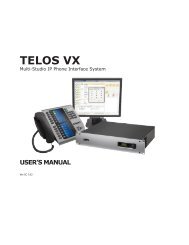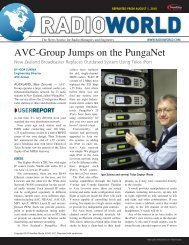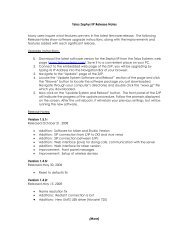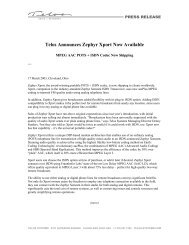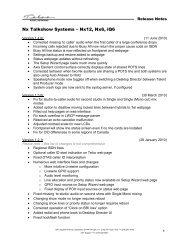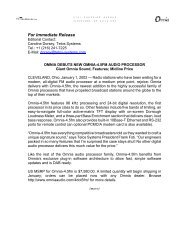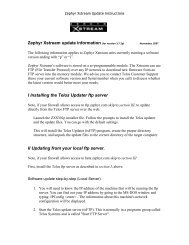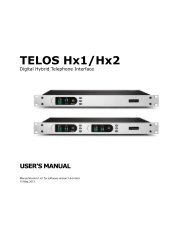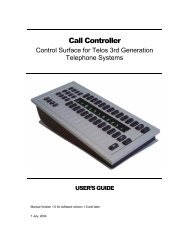NOW! 12-13 - Telos
NOW! 12-13 - Telos
NOW! 12-13 - Telos
Create successful ePaper yourself
Turn your PDF publications into a flip-book with our unique Google optimized e-Paper software.
TECHTALK BLOG<br />
TELOSALLIANCE.COM/BLOG<br />
AVB claims to be an inherent capability of standard networking<br />
equipment, implying that, unlike AoIP, AVB would not require<br />
an engineered network. But when you look closely, this seemingly<br />
huge advantage starts fading.<br />
Support of IEEE 802.1AS (subset of IEEE 1588) is mandatory in<br />
all switches and terminal devices. Support of IEEE 802.1Qat,<br />
the Stream Reservation Protocol (SRP), is mandatory too. Since<br />
AVB trafic cannot be routed through network equipment that<br />
is not AVB-enabled, it effectively still requires an engineered<br />
network – at least in terms of careful selection of the switch<br />
models (until such time as AVB is included in all industrially<br />
made switches).<br />
And even with all AVB-enabled network equipment in place, signiicant<br />
restrictions remain. AVB is layer-2, not routable, so the<br />
audio trafic cannot pass the boundaries of LAN subnets. Don’t<br />
even think about WAN links. And only 75% of the bandwidth<br />
can be reserved for actual AVB trafic. While generally this kind<br />
of a restriction makes sense for mixed-application networks, it<br />
robs 25% of the bandwidth from a dedicated audio setup.<br />
WHAT’S IN AoIP’S FUTURE?<br />
No one can say for sure. But there are some things peeking<br />
over the horizon that are worth mentioning.<br />
INTEROPERABILITY<br />
The value of a networking technology is only as great as the<br />
number of devices it allows to interconnect. Users and manufacturers<br />
realize this – several interoperability initiatives have<br />
appeared, and some of them have already produced useful<br />
results. These initiatives indicate a new level of AoIP evolution.<br />
EBU – ACIP project: The Audio Contribution over IP (ACIP) project<br />
lead by the network division at EBU, is perhaps the earliest<br />
major initiative that has already produced practically useful<br />
results. Recognizing the fact that more and more equipment<br />
is using IP links for audio contribution, EBU launched a project<br />
group in 2006 to develop minimum interoperability requirements<br />
for devices interconnected via IP. Agreement on a common<br />
standard was reached in September of 2007. The standard<br />
is based on a number of IETF documents, in particular RTP over<br />
UDP for audio streaming, and SIP for session management. It<br />
also deines a number of mandatory audio codecs to be supported<br />
by all compliant devices, as well as a number of recommended<br />
codecs. The project proved to be successful – most<br />
of the manufacturers taking part in the plug tests in 2009 appeared<br />
compatible.<br />
AES – X.192: The effort started by the EBU ACIP project is<br />
logically continued by the AES X.192 high-performance AoIP<br />
interoperability project, attempting to reconcile the existing<br />
in-facility AoIP networking solutions. This project has chosen<br />
an approach to identify an area of overlap, where the different<br />
technologies might be able to interoperate, hopefully with<br />
no, or minor enhancements. A task group, of which Axia is a<br />
BROCHURES<br />
AXIAAUDIO.COM/BROCHURES<br />
SOFTWARE UPDATES<br />
AXIAAUDIO.COM/DOWNLOADS<br />
member, has been created and is working on a draft document.<br />
More information can be read at www.x192.org.<br />
NRJ Networks, Paris<br />
World’s largest AoIP mixing console? Likely. This 36-position, 28-fader<br />
Axia Element is in the master control room of NRJ Networks, Paris.<br />
WIDE-AREA AoIP NETWORKS<br />
Network bandwidth and latency, and (to some extent) the processing<br />
power of network devices are the main factors limiting<br />
AoIP applications. But these factors are also the ones we can<br />
observe evolving quickly and steadily. The cost of processing<br />
power is reasonably low, and keeps dropping, allowing network<br />
devices to become faster as well as functionally more<br />
capable. Huge amounts of bandwidth are added to backbone<br />
links worldwide every month; more and more connections get<br />
upgraded to high-speed copper and optical links, and new wireless<br />
technologies cover low-density areas. This stimulates services<br />
that were originally conceived for use only on a LAN to<br />
break the walls of the closed networks and go out to the WAN.<br />
MPLS (Multi-Protocol Label Switching) is a technology that<br />
helps greatly here. Although MPLS doesn’t create new bandwidth,<br />
it allows utilizing WAN bandwidth for LAN protocols and<br />
applications without any redesign of the latter. It is capable of<br />
tunneling Ethernet frames to transparently link distant clusters<br />
of a virtual LAN.<br />
The Virtual Private LAN Service (VPLS) is well known and<br />
widely deployed, but has yet to ind its way into broadcast<br />
applications. When backbone networks build up suficient<br />
FIND A DEALER<br />
AXIAAUDIO.COM/BUY<br />
IP-AUDIO STUDIO NETWORKING | AoIP CONSOLES | AUDIO INTERFACES | IP INTERCOMS | ROUTING AUTOMATION<br />
AXIAAUDIO.COM<br />
101




